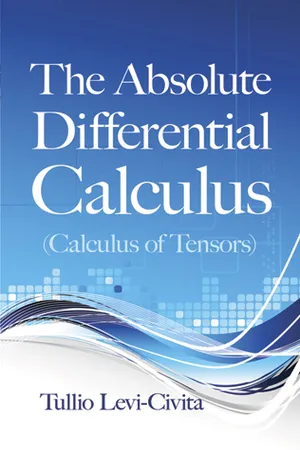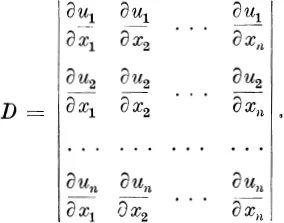
- 452 pages
- English
- ePUB (mobile friendly)
- Available on iOS & Android
eBook - ePub
The Absolute Differential Calculus (Calculus of Tensors)
About this book
Written by a towering figure of twentieth-century mathematics, this classic examines the mathematical background necessary for a grasp of relativity theory. Tullio Levi-Civita provides a thorough treatment of the introductory theories that form the basis for discussions of fundamental quadratic forms and absolute differential calculus, and he further explores physical applications.
Part one opens with considerations of functional determinants and matrices, advancing to systems of total differential equations, linear partial differential equations, algebraic foundations, and a geometrical introduction to theory. The second part addresses covariant differentiation, curvature-related Riemann's symbols and properties, differential quadratic forms of classes zero and one, and intrinsic geometry. The final section focuses on physical applications, covering gravitational equations and general relativity.
Part one opens with considerations of functional determinants and matrices, advancing to systems of total differential equations, linear partial differential equations, algebraic foundations, and a geometrical introduction to theory. The second part addresses covariant differentiation, curvature-related Riemann's symbols and properties, differential quadratic forms of classes zero and one, and intrinsic geometry. The final section focuses on physical applications, covering gravitational equations and general relativity.
Frequently asked questions
Yes, you can cancel anytime from the Subscription tab in your account settings on the Perlego website. Your subscription will stay active until the end of your current billing period. Learn how to cancel your subscription.
No, books cannot be downloaded as external files, such as PDFs, for use outside of Perlego. However, you can download books within the Perlego app for offline reading on mobile or tablet. Learn more here.
Perlego offers two plans: Essential and Complete
- Essential is ideal for learners and professionals who enjoy exploring a wide range of subjects. Access the Essential Library with 800,000+ trusted titles and best-sellers across business, personal growth, and the humanities. Includes unlimited reading time and Standard Read Aloud voice.
- Complete: Perfect for advanced learners and researchers needing full, unrestricted access. Unlock 1.4M+ books across hundreds of subjects, including academic and specialized titles. The Complete Plan also includes advanced features like Premium Read Aloud and Research Assistant.
We are an online textbook subscription service, where you can get access to an entire online library for less than the price of a single book per month. With over 1 million books across 1000+ topics, we’ve got you covered! Learn more here.
Look out for the read-aloud symbol on your next book to see if you can listen to it. The read-aloud tool reads text aloud for you, highlighting the text as it is being read. You can pause it, speed it up and slow it down. Learn more here.
Yes! You can use the Perlego app on both iOS or Android devices to read anytime, anywhere — even offline. Perfect for commutes or when you’re on the go.
Please note we cannot support devices running on iOS 13 and Android 7 or earlier. Learn more about using the app.
Please note we cannot support devices running on iOS 13 and Android 7 or earlier. Learn more about using the app.
Yes, you can access The Absolute Differential Calculus (Calculus of Tensors) by Tullio Levi-Civita in PDF and/or ePUB format, as well as other popular books in Mathematics & Calculus. We have over one million books available in our catalogue for you to explore.
Information
PART I
Introductory Theories
CHAPTER I
FUNCTIONAL DETERMINANTS AND MATRICES
1.Geometrical terminology.
In analytical geometry it frequently happens that complicated algebraic relationships represent simple geometrical properties. In some of these cases, while the algebraic relationships are not easily expressed in words, the use of geometrical language, on the contrary, makes it possible to express the equivalent geometrical relationships clearly, concisely, and intuitively. Further, geometrical relationships are often easier to discover than are the corresponding analytical properties, so that geometrical terminology offers not only an illuminating means of exposition, but also a powerful instrument of research. We can therefore anticipate that in various questions of analysis it will be advantageous to adopt terms taken over from geometry.
For this purpose it is essential to adopt the fundamental convention of using the term point of an abstract n-dimensional manifold (n being any positive integer whatever) to denote a set of n values assigned to any n variables x1, x2, … xn. This is an obvious extension of the use of the term in the one-to-one correspondence which can be established between pairs or triplets of co-ordinates and the points of a plane or space, for the cases n = 2 and n = 3 respectively. For the case of n variables we can thus also speak of a field of points (rather than of values assigned to the x’s), and of the region round a specified point xi (i = 1, 2, … n).
If the x’s are n functions xi(t) of a real variable t, then when t varies continuously between t0 and t1 we get a simply infinite succession of points, the aggregate of which (as for n = 2 and n = 3) is called a line, and more precisely an arc or segment of a line.
2.Functional determinants and change of variables.
Let there be n functions of n variables:
ui(x1, x2, … xn),
the functions and their derivatives to any required degree being supposed finite and continuous in the field considered.
To simplify the notation, let x (without a suffix) represent not only (as is usual) any one of the n variables x1, x2, … xn, but also (as is sometimes done) the whole set of them; and similarly for other letters which will be used farther on. With this convention the given functions can be written in the abridged form:
ui(x).
With the usual notation, the functional determinant or Jacobian of the u’s is the determinant of the nth order whose terms are the first derivatives of the u’s; i.e.

Such a determinant is sometimes represented by the abridged notation

analogous to that used for fractions and substitutions, the set of functions u representing the numerator and the set of variables x the denominator of a fraction. The analogy of form is justified by the analogy of properties, as can be seen by considering the effect on a functional determinant of a change of variables. For let the x’s be functions of n variables y,

and suppose further that these equations represent a reversible transformation, i.e. that they also define the y’s as functions of the x’s, or, in other words, that they are soluble with respect to the y’s. If then the u’s are considered as functions of the y’s (being given in terms of the x’s, which are functions of the y’s), and the corresponding functional determinant

is formed, it will be found, as will be shown below in § 4, that D1 = D multiplied b...
Table of contents
- Cover
- Title Page
- Copyright Page
- Preface
- Preface to the First (Italian) Edition
- References
- Note to Second English Impression
- Publisher’s Note
- Contents
- Part I—Introductory Theories
- Part II—The Fundamental Quadratic Form and the Absolute Differential Calculus
- Part III.—Physical Applications
- Additional Notes
- Index of Names
- General Index